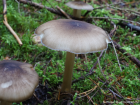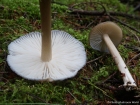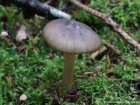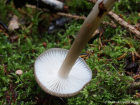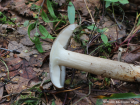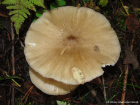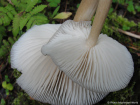Cap mid- to pale brown, convex to umbonate. It has radiating fibres on a dry cap surface. In dry weather, the caps of this mushroom sometimes split radially at the margins. Gills white, becoming cream colored. Reaching to the stem but not attached and they are crowded and very broad. Stem hollow at the centre and whitish, with darker fine fibrils that are less dense than on the cap. It is more or less equal and thickened at the base. It has no ring. Spore print white.
Microscopic Features: The spores are broadly ellipsoidal, smooth, have a size range of 7-10μm in length and 6-8.5μm in width and are inamyloid.
Note: Until recently, it was believed that this species could be found in certain regions of North America. However, further research has revealed that the specimens from the United States are not conspecific with Megacollybia platyphylla and have been classified as a separate species.
Megacollybia platyphylla on the www.first-nature.com web site.
Many mushrooms are poisonous, and some can be lethally toxic. Distinguishing between edible and poisonous mushrooms can be very challenging. Therefore, we strongly advise against consuming wild mushrooms. This website does not contain any information about the edibility or toxicity of mushrooms.
Although efforts have been made to ensure accuracy on this website, the information may contain errors and omissions. Therefore, all content provided is for educational and informational purposes only and should not be relied upon or used as a basis for consuming any plants or mushrooms.
External links are provided for reference only. We do not endorse or take responsibility for the content, advice, or products found on these sites or in any advertisements shown on this website.
